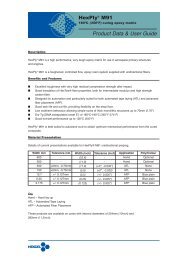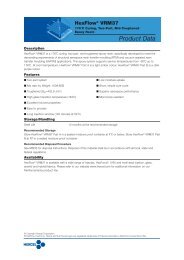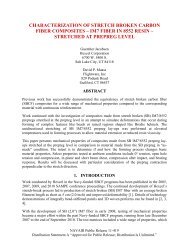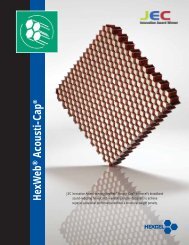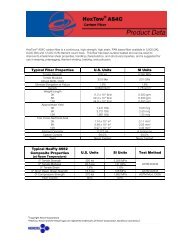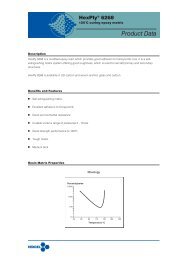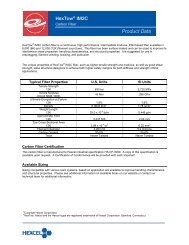failure initiation and effect of defects in structural ... - Hexcel.com
failure initiation and effect of defects in structural ... - Hexcel.com
failure initiation and effect of defects in structural ... - Hexcel.com
Create successful ePaper yourself
Turn your PDF publications into a flip-book with our unique Google optimized e-Paper software.
• Vary<strong>in</strong>g levels <strong>of</strong> chip misalignment<br />
o 4 chips (surface chips or <strong>in</strong>terply dispersed)<br />
o 8 chips ( surface chips or <strong>in</strong>terply dispersed)<br />
o 16 chips( surface chips or <strong>in</strong>terply dispersed)<br />
• Butt splice (cut the surface ply or center ply before mold<strong>in</strong>g)<br />
Us<strong>in</strong>g acoustic emission for monitor<strong>in</strong>g damage <strong>and</strong> predict<strong>in</strong>g ultimate <strong>failure</strong> based on the AE<br />
signature levels is accepted for high pressure tanks, crane arms <strong>and</strong> w<strong>in</strong>d blades [3][4][5]. This<br />
NDI monitor<strong>in</strong>g method has ga<strong>in</strong>ed more widespread use for CFC [6][7][8]. Hence, it is well<br />
suited for record<strong>in</strong>g first cracks <strong>in</strong> DFC to see if they correlate to ultimate strength.<br />
To <strong>com</strong>pare the auditory first crack results with AE, we established a limit <strong>of</strong> 3.0 volts as the<br />
“auditory” threshold for AE monitor<strong>in</strong>g. Crack events with an <strong>in</strong>tensity <strong>of</strong> about 3.0 V seemed to<br />
be on the low end <strong>of</strong> be<strong>in</strong>g audible. As a reference, total <strong>failure</strong> crack events registered around<br />
6.5V. (Figure 13 shows an example AE pr<strong>of</strong>ile for a HexMC tensile sample). There was aga<strong>in</strong> no<br />
correlation between the first crack event <strong>and</strong> the ultimate strength, see Figure 14. While the<br />
average strength <strong>of</strong> samples with misalignment or butt splice <strong>defects</strong> went down, the stress at<br />
which po<strong>in</strong>t the first crack occurred did not change. This simply <strong>in</strong>dicates first cracks <strong>in</strong> DFC<br />
occurred <strong>in</strong> areas with the weakest conformation; be it man-made or r<strong>and</strong>om.<br />
4 chip stack Chip fibers aligned<br />
perpendicular to load direction<br />
3 ply lam<strong>in</strong>ate<br />
Figure 13. Example AE pr<strong>of</strong>ile for a HexMC tensile test. This sample had four chips manually<br />
oriented <strong>and</strong> stacked perpendicular to the load direction which represented about 16% <strong>of</strong> the total<br />
number <strong>of</strong> stacked chips through the thickness (≅ 24 chips). This sample failed at 343 MPa -<br />
106% <strong>of</strong> the nom<strong>in</strong>al strength (324 MPa).<br />
Table 2 summarizes the average strength results for each category <strong>of</strong> specimens. Expectedly,<br />
samples with deliberate <strong>defects</strong> generally fail at a lower load. However, the stress at which the<br />
first AE peak occurs stays the same. For specimens with no <strong>defects</strong>, the average stress at the first<br />
AE peak was 146 ±34 MPa, while samples with a butt splice <strong>in</strong> them had the first AE peak<br />
around 122 ±28 MPa.





